Grocery and Transportation Maps
November 8, 2021
The Flint Leverage Points Project (FLPP) Grocery Map is an interactive map of food retail locations discussed by Flint residents who participated in the FLPP stakeholder mapping workshops (see Briefing Note 2 and Briefing Note 5 for more details) and Flint Photo Project.
The map is not intended to be a complete representation of all food retailers in Flint, but rather a visual overview of stores discussed by participants in the FLPP. We heard from residents about challenges with transportation to food stores, so we connected data from residents about shopping with public transportation routes to provide further illustration of barriers and identify ideas for positive change.
More information about each store as described by Flint residents is provided in the sidebar that appears when clicking on the location in the interactive map.
This project is designed to promote action! Please tell us how to improve this map, and how you envision using it!
*Note: The statements provided here represent the voices of the Flint residents who participated in this research project. They are not necessarily reflective of the values or opinions of Michigan State University or its affiliates.
Interactive Grocery Map
If you’re having trouble viewing this map, try opening this page in a private window.
Groups of stores
Stores or businesses in the FLPP Grocery Map are divided into three categories. The "frequently shopped" category (purple) includes locations that serve as primary sources of food and were frequently described in most of our participant workshops. Locations described as "occasionally shopped" (green) indicate stores that were not always the primary destination, served to supplement food from other locations, or supply important specialty goods. Finally, the category "less frequently shopped" (orange) includes stores participants discussed, but revealed that they do not shop there often for a variety of reasons. Reasons described by Flint residents included: the stores fulfilled infrequent food needs like celebratory or ethnic foods, or residents experienced barriers to access such as store location, pricing of essential foods, or otherwise expressed desires to avoid the location.
More details about what Flint residents say about each store can be found in the sidebar information box when you click on each store location in the interactive map.
*Note: The statements provided here represent the voices of the Flint residents who participated in this research project. They are not necessarily reflective of the values or opinions of Michigan State University or its affiliates.
Suggested citation
Sufyan, G., Wentworth, C., Zaman, N. & Hodbod, J. (2021). Flint Leverage Points Project Grocery Map [Interactive Map]. Flint, Michigan: Community Foundation of Greater Flint and Michigan State University.
Maps for Download
In addition to the interactive map above, we have made several snapshot maps. Each of these maps show a component of the Flint food system and are available for anyone to use and download for free.
Overview Map of FLPP Grocery Store Locations near Flint
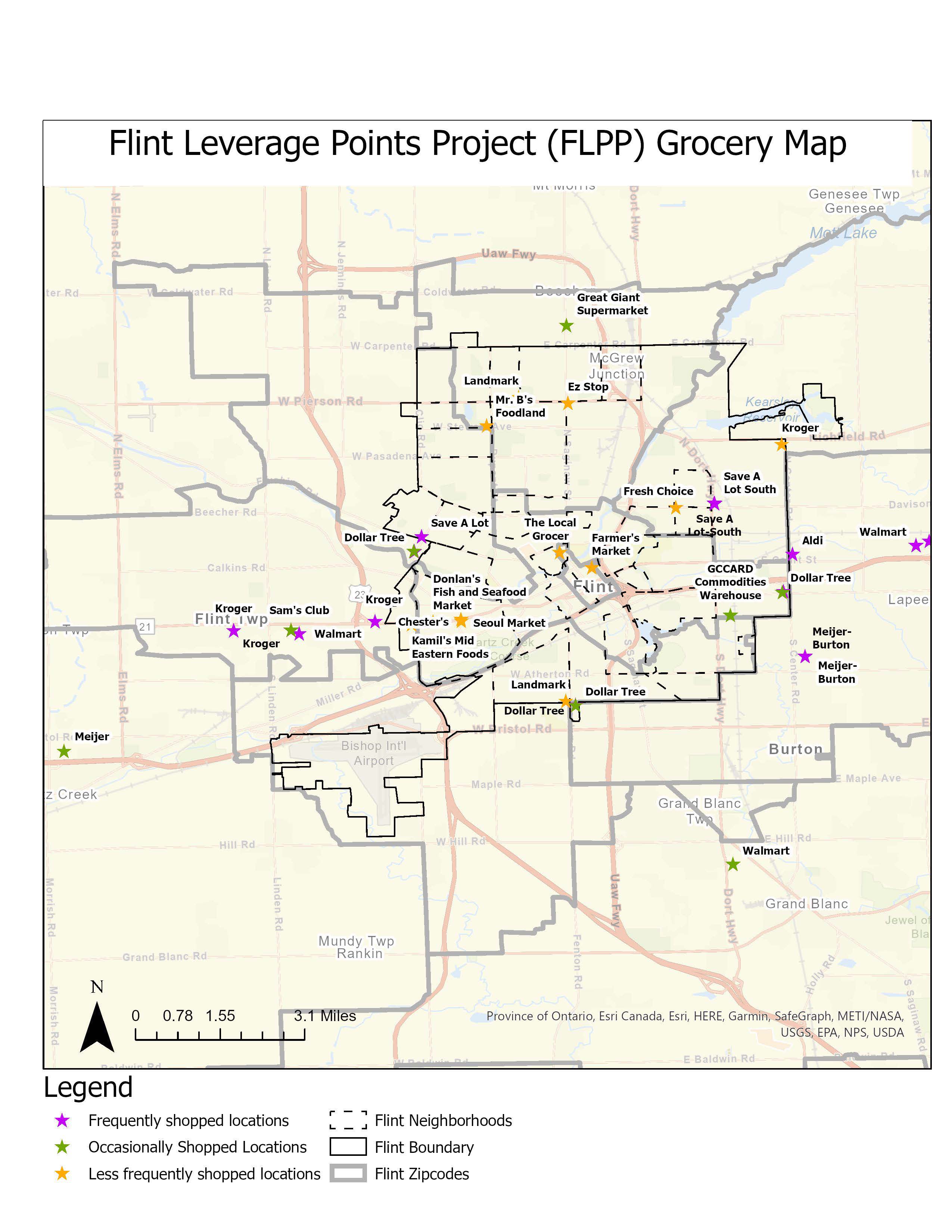
This map provides an overview of grocery stores mentioned by FLPP research participants within and around the Flint city boundaries. Stores across all three categories are named here to orient viewers familiar with the area. Full information on all the stores is available on the interactive map above.
*Note: The statements provided here represent the voices of the Flint residents who participated in this research project. They are not necessarily reflective of the values or opinions of Michigan State University or its affiliates.
Frequently Shopped Locations FLPP Map
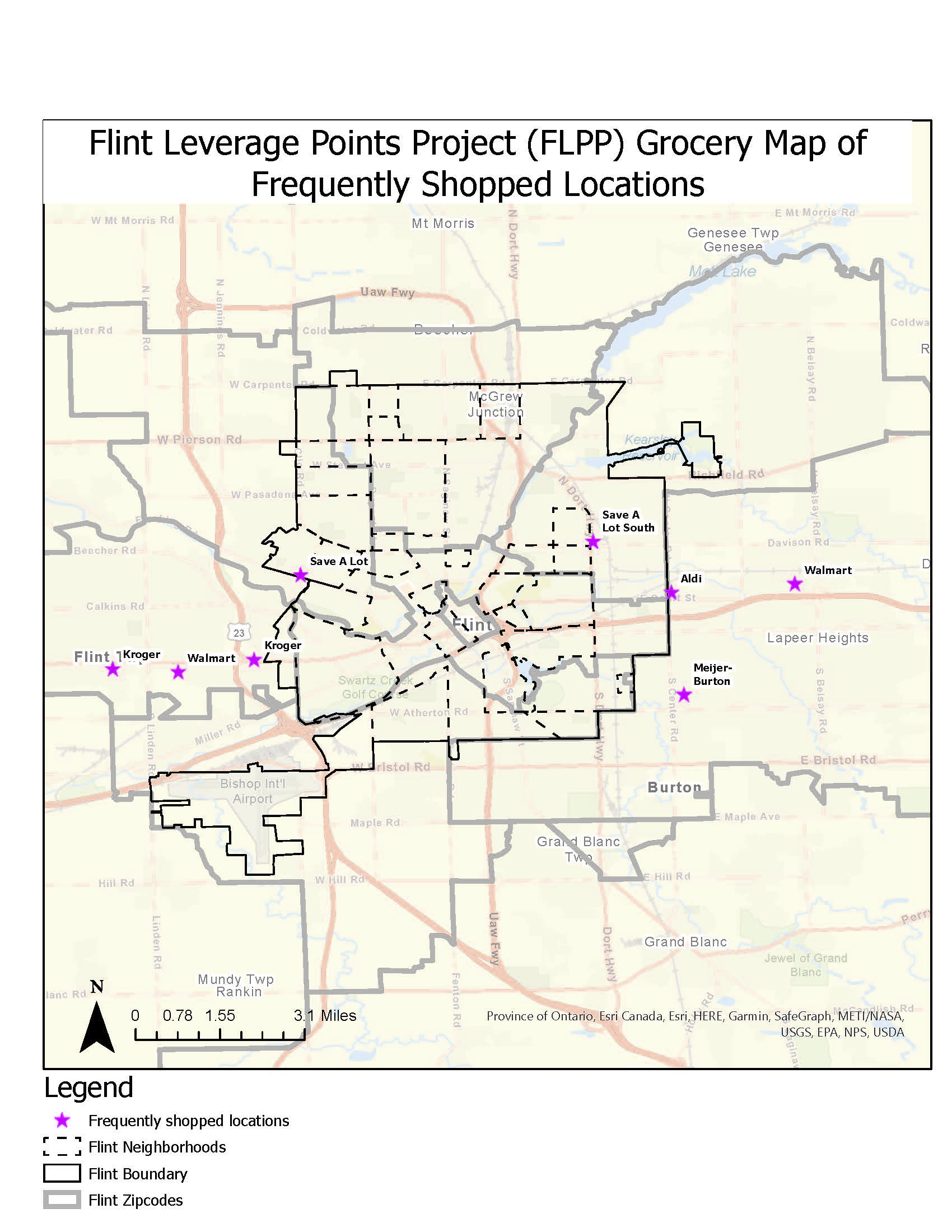
This version of the FLPP Grocery Map shows only the “frequently shopped” locations mentioned by participants. This map highlights two main observations about these locations. First these grocery stores are all located on the border or outside of Flint. Second, travel distance and time is significant for residents relying on public transportation. Full information on all the stores is available on the interactive map above.
*Note: The statements provided here represent the voices of the Flint residents who participated in this research project. They are not necessarily reflective of the values or opinions of Michigan State University or its affiliates.
Download Frequently Shopped Locations FLPP Map (PDF)
Occasionally Shopped Locations FLPP Map
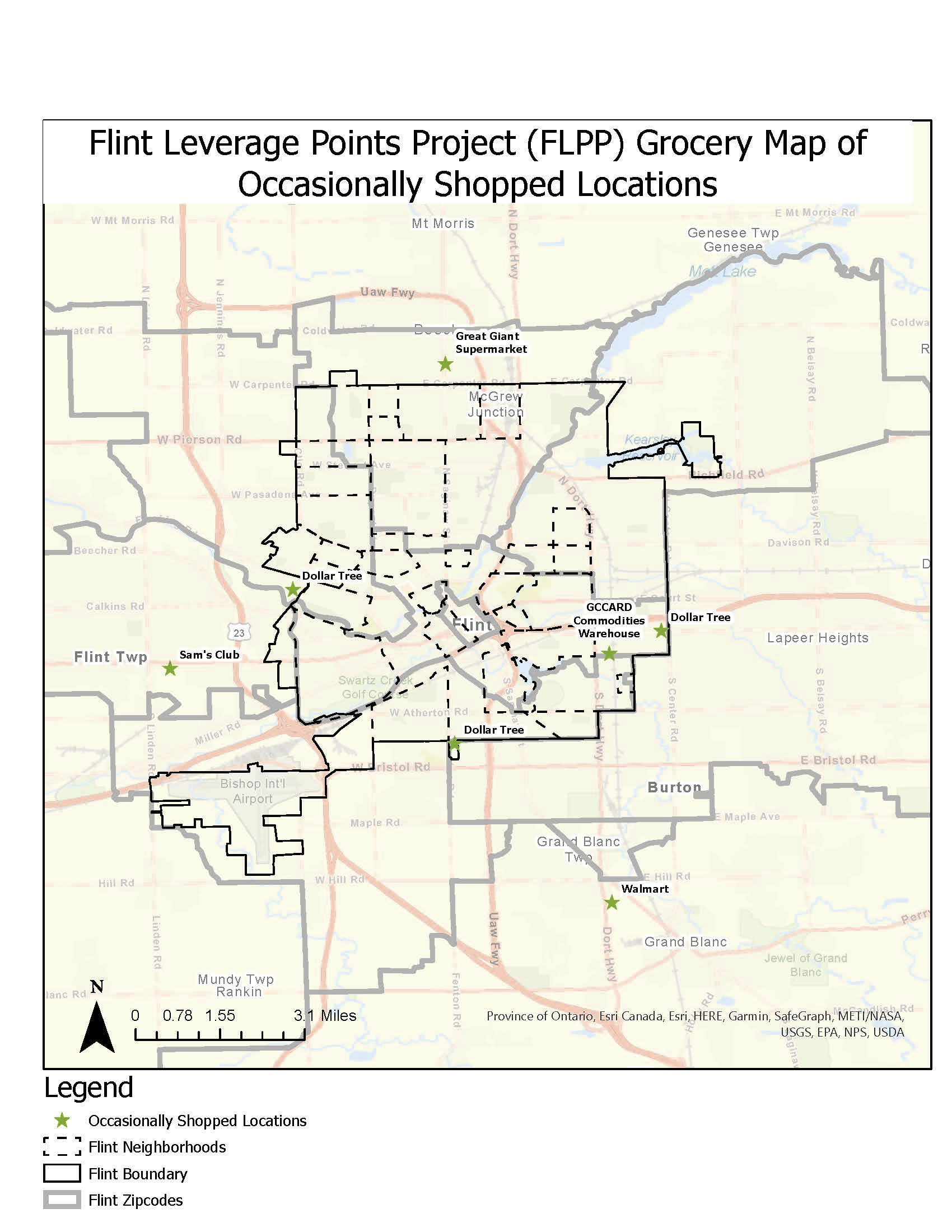
This map shows “occasionally shopped” locations described by FLPP participants. Occasionally shopped locations are places Flint residents described primarily as supplemental to the main grocery trips. One example of this is the GCCARD Warehouse, a supplemental food pantry that was an important food source for senior participants. Other stores in this category include stores that are further away like the Walmart in Grand Blanc and the Sam’s Club in Swartz Creek, which shows many people cannot rely on stores further away as their main shopping locations. Full information on all the stores is available on the interactive map above.
*Note: The statements provided here represent the voices of the Flint residents who participated in this research project. They are not necessarily reflective of the values or opinions of Michigan State University or its affiliates.
Download Occasionally Shopped Locations FLPP Map (PDF)
All Less Frequently Shopped Locations Full Map
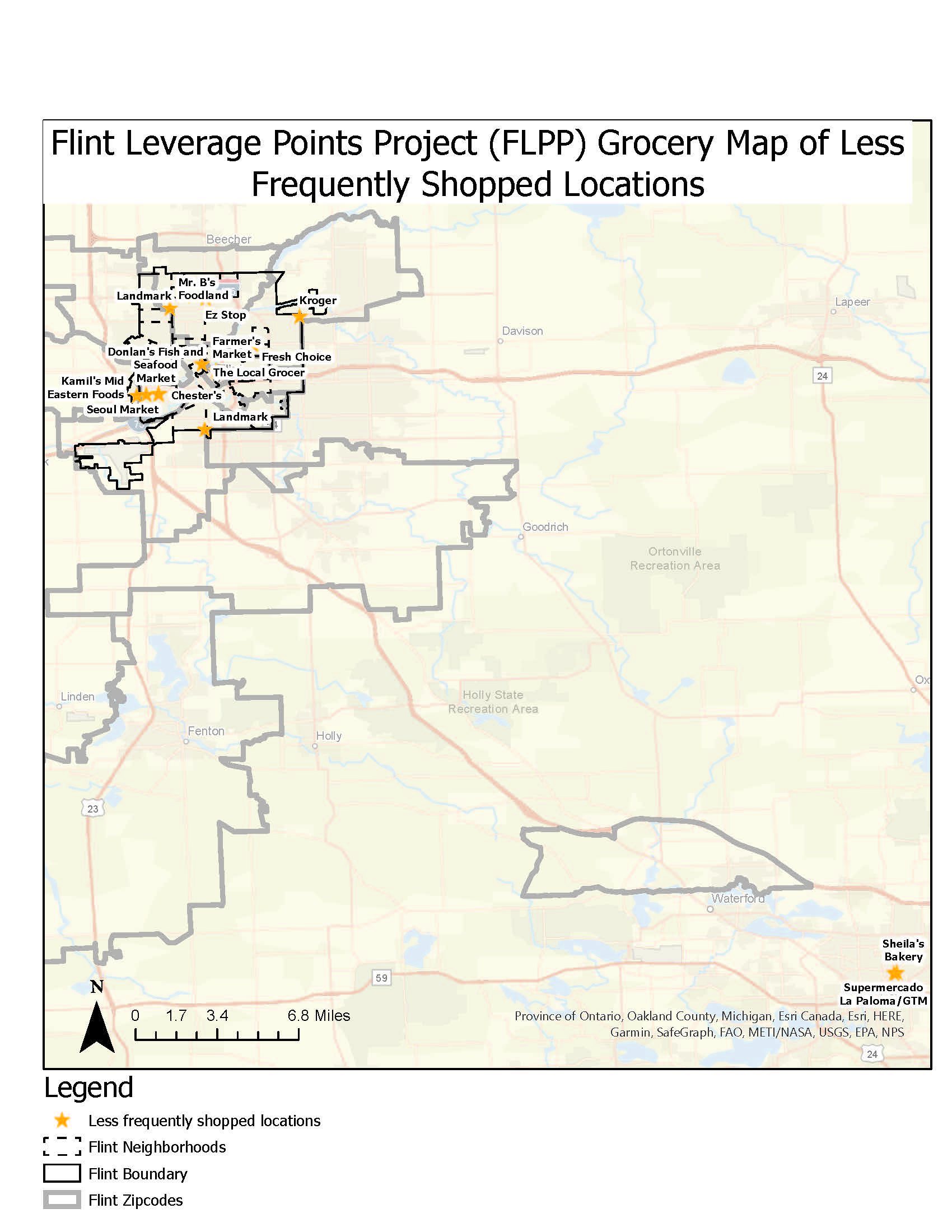
This map shows “less frequently shopped” locations as described by FLPP participants. This includes stores that participants discussed but explained that they do not often shop at for a variety of reasons, including the store is hard to get to, the store is only needed for special occasion items, or the store is not a primary destination due to other barriers. This map is zoomed out to show locations in Pontiac mentioned by Latinx participants as a source of Hispanic/Latino foods not available in Flint. While these stores were greatly appreciated and used, the distance from Flint made these Pontiac locations less frequently shopped according to participants.
*Note: The statements provided here represent the voices of the Flint residents who participated in this research project. They are not necessarily reflective of the values or opinions of Michigan State University or its affiliates.
Download All Less Frequently Shopped Locations Full Map (PDF)
Less Frequently Shopped Locations Flint Map
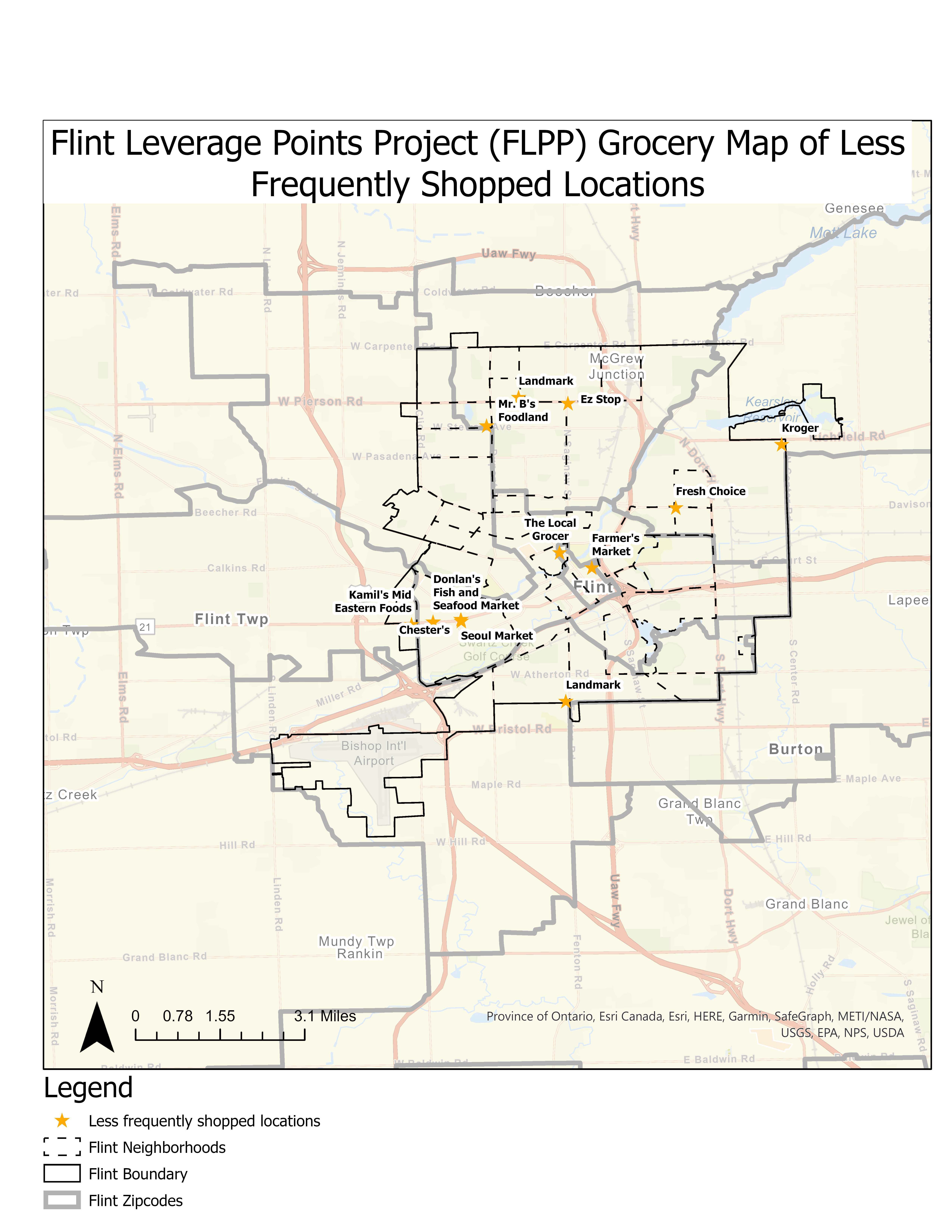
This map shows “less frequently shopped” locations as described by FLPP participants, but focuses only on the locations nearest to the city limits. Less frequently shopped locations includes stores that participants discussed but explained that they do not often shop at for a variety of reasons, including the store is hard to get to, the store is only needed for special occasion items, or the store is not a primary destination due to other barriers. The few areas and store locations mentioned on this map are placed to orient viewers to the area this map covers. The less frequently shopped locations are mostly within the city boundaries, a major difference from the “frequently shopped” and even the “occasionally shopped” maps.
*Note: The statements provided here represent the voices of the Flint residents who participated in this research project. They are not necessarily reflective of the values or opinions of Michigan State University or its affiliates.
Download Less Frequently Shopped Locations Flint Map (PDF)
Primary MTA Flint Bus Routes with FLPP Grocery Map

An overview of the primary Mass Transportation Authority (MTA) bus routes servicing Flint in 2021. The route numbers are overlayed onto each color-coded line. This provides one illustration of how public transportation services the grocery locations described by Flint residents in the FLPP. This map illustrates that residents of North Flint need to transfer bus lines to reach stores participants deemed most frequently shopped. It also shows that most stores are serviced by only a single bus route which limits the residents who can access the store without making a transfer. Making a bus transfer with groceries is a major barrier to using public transportation to access food.
*Note: The statements provided here represent the voices of the Flint residents who participated in this research project. They are not necessarily reflective of the values or opinions of Michigan State University or its affiliates.
Download Primary MTA Flint Bus Routes with FLPP Grocery Map (PDF)
MTA Bus Stop Locations with FLPP Grocery Map
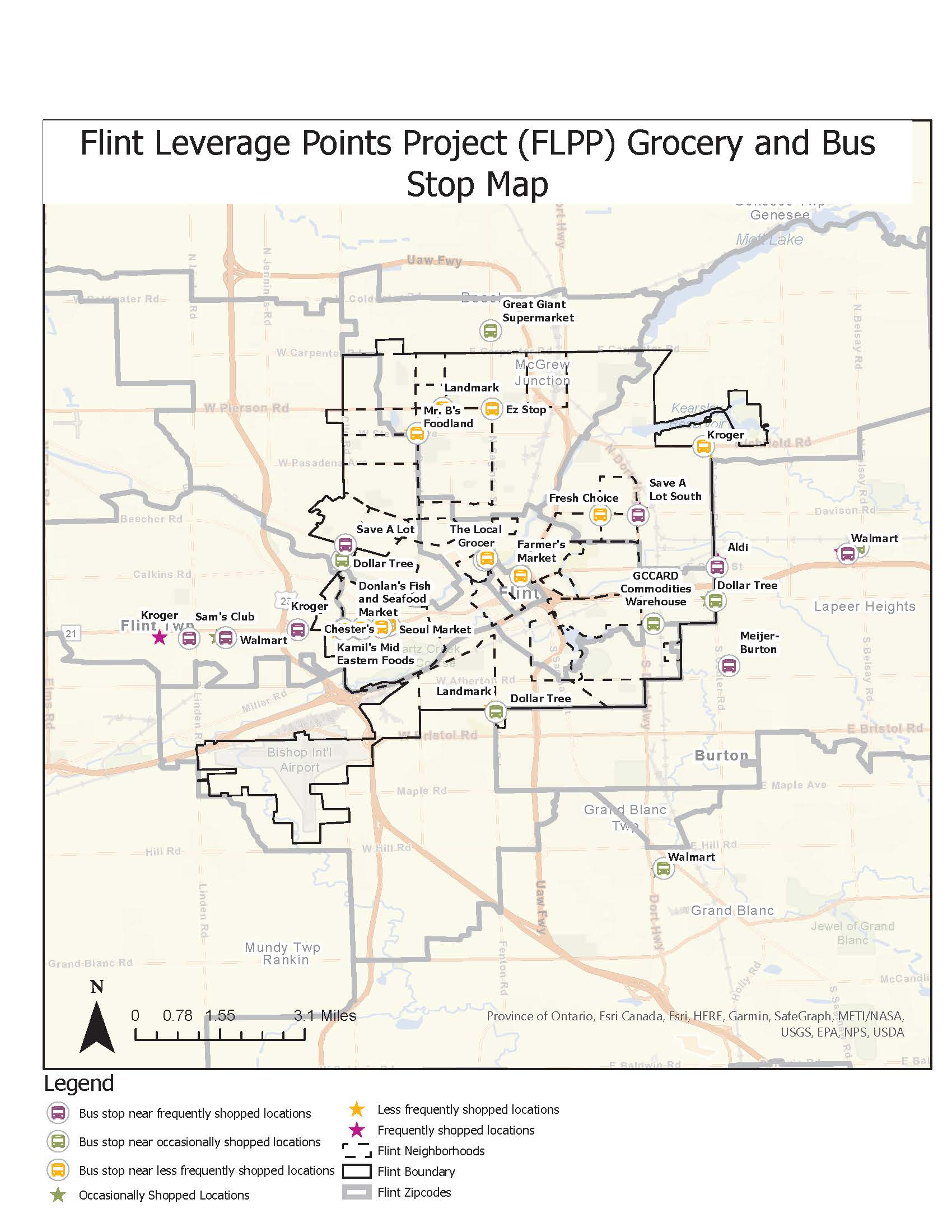
This map shows the bus stop nearest to each grocery location on the FLPP Grocery Map. This provides a visual overview of the distance from each store to a bus stop. While urban planning research considers a 0.25 mile distance a walkable and accessible distance (Atash, 1994), participants explain challenges associated with this. Flint residents describe the difficult reality of navigating that distance in the snow, with small children, and while carrying lots of heavy bags of food. Backed by data, we challenge the assumption that bus stop locations are accessible within this standardized distance. Flint residents shared information about barriers to accessing stores via public transportation, which provides critical insight on how to improve access to stores.
*Note: The statements provided here represent the voices of the Flint residents who participated in this research project. They are not necessarily reflective of the values or opinions of Michigan State University or its affiliates.
Download MTA Bus Stop Locations with FLPP Grocery Map (PDF)
*Note: The statements provided here represent the voices of the Flint residents who participated in this research project. They are not necessarily reflective of the values or opinions of Michigan State University or its affiliates.



 Print
Print Email
Email